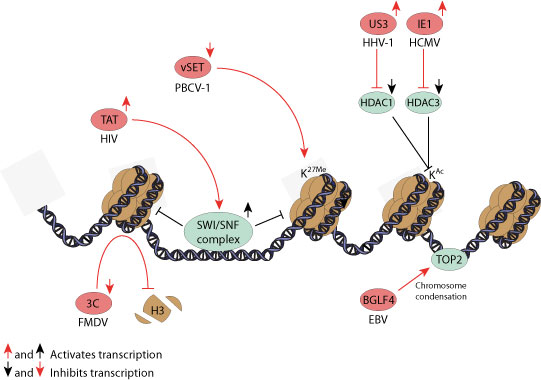Modulation of host chromatin by virus (kw:KW-1122)
Chromatin is defined as the structure that organizes DNA within the nucleus of eukaryotic cells. Histones play an essential function in the chromatin organization. They package and order the DNA into structural units called nucleosome. They undergo posttranslational modifications that affect their interaction with DNA and nuclear proteins. For example, histone acetylation is a hallmark of actively transcribed chromatin while methylation lead to either activated or repressed chromatin.

Many viruses evovled mechanisms to modulate chromatin factors to complete their life cycle. Nuclear entry, transcription, genome stabilization and virion packaging involve complex modulation of host chromatin. Paramecium bursaria chlorella virus 1 encodes vSET, a viral homolog of cellular SET protein and methylates specifically histone H3 at lysine-27 leading to rapid inhibition of host transcription after viral infection. Herpes simplexvirus VP16 protein recruits co-activators and transcription factors to IE promoters dissociating histones from these promoters while Us3 protein inhibits HDAC1. HIV protein TAT recruits the SWI/SNF chromatin remodelling complex to long terminal repeat (LTR) in order to increase its transactivating activities. Epstein-Barr virus BGLF4 modulates both host condensin and topoisomerase II. Human cytomegalovirus proteins IE1 and IE2 interact with host histone deacetylase HDAC3. This ability to modify chromatin is fundamental to transcriptional activation by IE1 and IE2.
Matching UniProtKB/Swiss-Prot entries
(all links/actions below point to uniprot.org website)69 entries grouped by protein
3 entries
Serine/threonine-protein kinase BGLF4 (EC 2.7.11.1)
12 entries
Genome polyprotein
43 entries
Protein Tat (Transactivating regulatory protein)
11 entries
